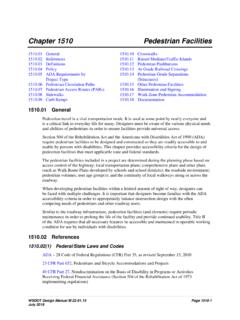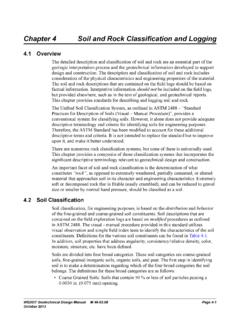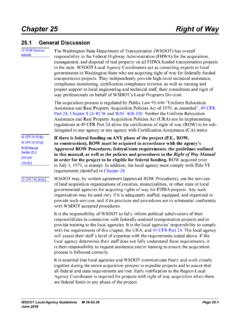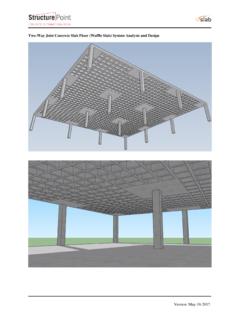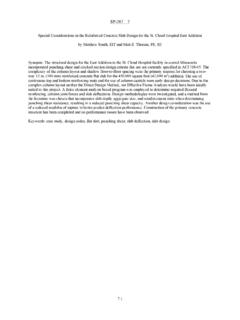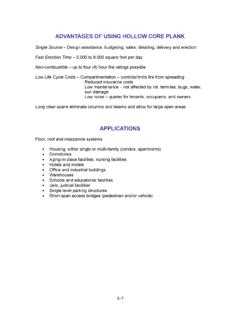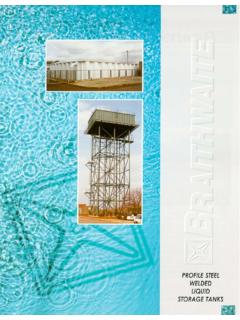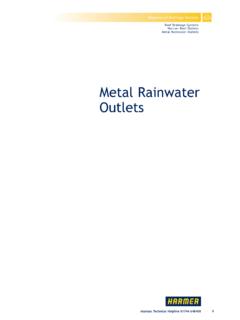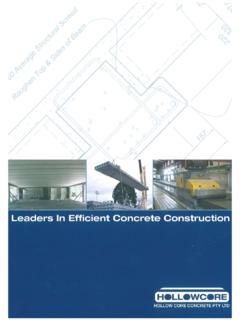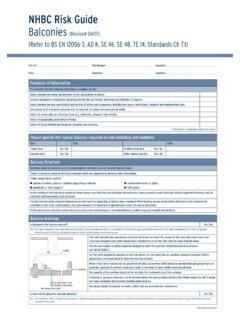Transcription of Chapter 10 Signs, Barriers, Approach Slabs, and Utilities ...
1 WSDOT Bridge design Manual M Page 10-i June 2018 Chapter 10 Signs, barriers , Approach Slabs, and Utilities sign and Luminaire Supports .. Loads .. Bridge Mounted Signs .. Monotube sign Structures Mounted on Bridges .. Monotube sign Structures .. Foundations .. Truss sign Bridges: Foundation Sheet design Guidelines .. Bridge Traffic barriers .. General Guidelines .. Bridge Railing Test Levels .. Available WSDOT Designs .. design Criteria .. At Grade Concrete barriers .. Differential Grade Concrete barriers .. Traffic Barrier Moment slab .. Precast Concrete Barrier .. Bridge Traffic Barrier Rehabilitation .. Policy .. Guidelines .. design Criteria .. WSDOT Bridge Inventory of Bridge Rails.
2 Available Retrofit Designs .. Available Replacement Designs .. Bridge Railing .. design .. Railing Types .. Bridge Approach Slabs .. Notes to Region for Preliminary Plan .. Bridge Approach slab design Criteria .. Bridge Approach slab Detailing .. Skewed Bridge Approach Slabs .. Approach Anchors and Expansion Joints .. Bridge Approach slab Addition or Retrofit to Existing Bridges .. Bridge Approach slab Staging ..10-40 Chapter 10 Signs, barriers , Approach Slabs, and UtilitiesPage 10-ii WSDOT Bridge design Manual M June Traffic Barrier on Bridge Approach Slabs .. Bridge Approach slab over Wing Walls, Cantilever Walls or Geosynthetic Walls . Bridge Approach slab over SE Walls .. Utilities Installation on New and Existing Structures.
3 General Concepts .. Utility design Criteria .. Box/Tub Girder Bridges .. Traffic Barrier Conduit .. Conduit Types .. Utility Supports .. Review Procedure for Utility Installations on Existing Structures .. Utility Review Checklist .. Anchors for Permanent Attachments .. Drainage design .. Bridge Security .. General .. design .. design Criteria .. Temporary Bridges .. General .. design .. NBI Requirements .. Submittal Requirements .. Bridge Standard Drawings .. References ..10-65 WSDOT Bridge design Manual M Page 10-1 June 2018 Signs, barriers , Chapter 10 Approach Slabs, and sign and Luminaire LoadsA. General The reference used in developing the following office criteria is the AASHTO LRFD Standard Specifications for Structural Supports for Highway Signs, Luminaires, and Traffic Signals, First Edition dated 2015 (including latest interims), and shall be the basis for analysis and Dead Loads sign : (Including panel and wind beams; does not include vert.)
4 Bracing) lbs/ft2 Luminaire (effective projected area of head = sq ft) 60 lbs/each Fluorescent Lighting lbs/ft Standard Signal Head 60 lbs/each Mercury Vapor Lighting lbs/each sign Brackets Calc. Structural Members Calc. 5 foot wide maintenance walkway: (Including mounting brackets and handrail) 160 lbs/ft Signal Head w/3 lenses: (Effective projected area with backing plate = sq ft) 60 lbs/eachC.
5 Live Load A live load consisting of a single load of 500 lb distributed over feet transversely to the member shall be used for designing members for walkways and platforms. The load shall be applied at the most critical location where a worker or equipment could be placed, see AASHTO 2015, Section Wind Loads A 3 second gust wind speed shall be used in the AASHTO wind pressure equation. The 3 second wind gust map in AASHTO is based on the wind map in ANSI/ASCE 7-16. Basic wind speed of 115 mph shall be used in computing design wind pressure using equation of AASHTO Section This is based on the high risk category with a mean recurrence interval of 1700 years per AASHTO Table The Alternate Method of Wind Pressures given in Appendix C of the AASHTO 2015 Specifications shall not be 10 Signs, barriers , Approach Slabs, and UtilitiesPage 10-2 WSDOT Bridge design Manual M June 2018E.
6 Fatigue design Fatigue design shall conform to AASHTO Section 11 with the exception of square and rectangular tube shape. AASHTO does not provide fatigue calculations for shapes with less than 8 sides. Therefore, calculating the Constant Amplitude Fatigue Threshold, DT (Table , AASHTO 2015) was taken to be the larger outer flat to flat distance of the rectangular tube. Fatigue Categories are listed in Table Overhead Cantilever and Bridge sign and signal structures, high-mast lighting towers (HMLT), poles, and bridge mounted sign brackets shall conform to the following fatigue categories. Fatigue Category I: Overhead cantilever sign structures (maximum span of 35 feet and no VMS installation), overhead sign bridge structures, high-mast lighting towers 55 feet or taller in height, bridge-mounted sign brackets, and all signal bridges.
7 Gantry or pole structures used to support sensitive electronic equipment (tolling, weigh-in-motion, transmitter/receiver antennas, transponders, etc.) shall be designed for Fatigue Category I, and shall also meet any deflection limitations imposed by the electronic equipment manufacturers. Fatigue Category II: For structures not explicitly falling into Category I or III. Fatigue Category III: Lighting poles 50 feet or less in height with rectangular or square cross sections, or non-tapered round cross sections, and overhead cantilever traffic signals (maximum cantilever length 65 feet). sign bridges, cantilever sign structures, signal bridges, and overhead cantilever traffic signals mounted on bridges shall be either attached to substructure elements ( , crossbeam extensions) or to the bridge superstructure at pier locations.
8 Mounting these features to bridges as described above will help to avoid resonance concerns between the bridge structure and the signing or signal structure. CCTV camera pole shall meet deflection criteria specified on Standard Plan J-29-15 for fixed base. The XYZ limitation shown in Table shall be met for Monotube Cantilevers. The XYZ limitation consists of the product of the sign area (XY) and the arm from the centerline of the posts to the centerline of the sign (Z). See Appendix for Ice and Snow Loads A 3 psf ice load may be applied around all the surfaces of structural supports, horizontal members, and luminaires, but applied to only one face of sign panels (Section , AASHTO 2015). Walk-through VMS shall not be installed in areas where appreciable snow loads may accumulate on top of the sign , unless positive steps are taken to prevent snow Group Load Combinations sign , luminaire, and signal support structures are designed using the load factors from Table , AASHTO 2015 (including latest interims).
9 Signs, barriers , Approach Slabs, and Utilities Chapter 10 WSDOT Bridge design Manual M Page 10-3 June Bridge Mounted SignsA. Vertical Clearance All new signs mounted on bridge structures shall be positioned such that the bottom of the sign or lighting bracket does not extend below the bottom of the bridge as shown in Figure The position of the sign does not need to allow for the future placement of lights below the sign . If lights are to be added in the future they will be mounted above the sign . To ensure that the bottom of the sign or lighting bracket is above the bottom of the bridge, the designer shall maintain at least a nominal 2 inch dimension between the bottom of the sign or lighting and the bottom of the bridge to account for construction tolerances and bracket arm sag.
10 Bridge mounted sign brackets shall be designed to account for the weight of added lights, and for the wind effects on the lights to ensure bracket adequacy if lighting is attached in the sign Vertical Clearance Chapter 10 Signs, barriers , Approach Slabs, and UtilitiesPage 10-4 WSDOT Bridge design Manual M June 2018B. Geometrics1. Signs shall be installed at approximate right angles to approaching motorists. For structures above a tangent section of roadway, signs shall be designed to provide a sign skew within 5 from perpendicular to the lower roadway (see Figure ).Figure sign Skew on Tangent Roadway 2. For structures located on or just beyond a horizontal curve of the lower roadway, signs shall be designed to provide a sign chord skew within 5 from perpendicular to the chord-point determined by the Approach speed (see Figure ).


